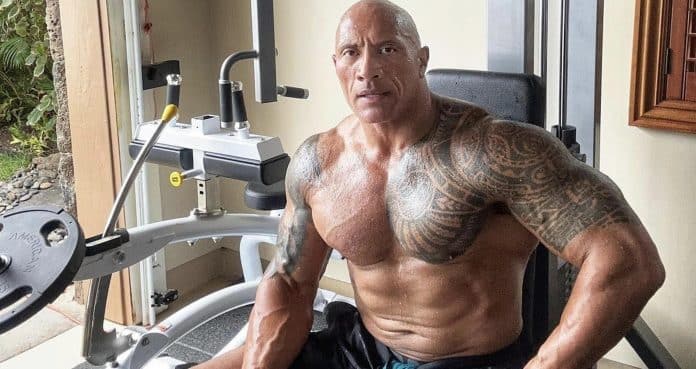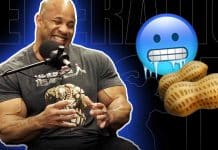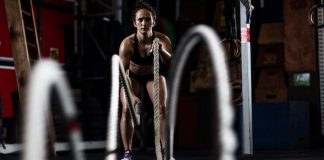
“The Rock” says controlling your movements is essential to get the most out of them.
The barbell row, also known as the bent-over row, is an excellent exercise for strengthening and building mass in your back (1). However, grip strength and stability can hinder optimal performance for many individuals. This post presents a superb alternative to the barbell row – “The Rock’s” back finisher – that you can incorporate into your workout routine, addressing these limitations while maintaining the desired results.
Not many people do it like Dwayne “The Rock” Johnson when combining fitness and an exceptional physique with entertainment. He’s famous for his time in the WWE and won the Man of the Century award at the Mr. Olympia. Johnson regularly shares his exercises with fans, and in this post, we’ll be looking at one, which is a barbell row alternative.
Since his wrestling days, The Rock has regularly improved his physique to become the shredded monster he is now. We’ll examine some workout principles he applies and how using them could lead to massive gains. The Rock posted this exercise as a back finisher he does late at night at his private home gym.
The Barbell Row Alternative
View this post on Instagram
The straight bar lat pulldown is Dwayne Johnson’s exercise as a back finisher. Like the barbell row, this exercise is a popular way to strengthen and grow your back. The back muscles involved in straight bar lat pulldown include the lats, traps, rhomboids, and levator scapulae. Below is a step-by-step guide on how to do the straight bar lat pulldown like The Rock does.
- Put the straight bar attachment on the higher point of the cable machine.
- Stand in front of the machine with your legs apart and one slightly in front of the other.
- Using an overhand grip, hold the bar at a wider distance than shoulder width.
- Lean forward slightly by hinging at your hips and brace your abs. This is your starting position.
- Start your movement by depressing your shoulder blades while extending your shoulders.
- Keeping your elbows slightly flexed, drag the bar down to your thighs.
- Pause and squeeze your lats for some seconds, and then slowly raise your arms to return to the starting position and complete the rep.
- Repeat for the number of reps to get to muscular failure.
The Rock uses the straight bar lat pulldown as a finisher for his back workout while standing, using a pronated grip, and wearing a weightlifting belt. Johnson states that he prefers the wide grip for this exercise. Research shows that using a wide grip for this routine is one of the best ways to activate and strengthen your lats (2). The straight arm pulldown is especially effective for the back because it excludes the biceps to force your lats to perform the movement.
Workout Principles Applied During Barbell Row Alternative Straight Bar Lat Pulldown

You’ll notice that The Rock does his straight-arm pulldowns with attention and care. He uses proper form and applies some essential principles that you can also use to make your workouts effective. Below are the ones he talked about in his post.
3-4 Seconds Negatives
Doing three to four-second negatives here means that The Rock uses the principle of eccentric training by doing controlled and slowed-down negatives in each rep. Working out this way increases the time that your muscles spend under tension. Increasing time under tension is a tested and trusted way to induce muscle growth (3). However, when doing slowed-down negatives, your weights shouldn’t be as heavy as usual.
1-2 Secs Squeeze Holds
The Rock applies the isometric holds and training principle when doing one to two-second squeeze holds. This type of resistance training is excellent for strengthening and toning your muscles and increases muscle hypertrophy (4). The Rock does this squeeze at the bottom of his pulldown.
Controlling Movement
The Rock also talks about doing your exercises in a controlled way. This lets you focus on using proper form and getting the most from your training. He writes, “Can’t emphasize enough to control your movements to get quality reps and to really work the muscle.”
Controlling your movements also allows you to focus on your mind-muscle connection. Research shows that a mind-muscle connection can better activate your muscles when exercising, leading to muscle growth (5). However, The Rock admits that doing a good finisher after your workout requires extra concentration.
“My back is fried at this point, so I really concentrate on controlling the reps all the way thru.”
Training Till Failure
Finally, The Rock discusses training until failure when doing this back finisher. He states that this is around a rep range of 8-12 reps for him. Research shows that training till failure leads to muscle hypertrophy and growth irrespective of load or number of reps (6).
The Rock’s Back Finisher Wrap Up
There aren’t many Hollywood movie stars with the type of exceptional physique that The Rock “Dwayne” Johnson has. When you look at his workouts and exercises, it’s easy to see why. This actor puts in the work and applies tested and trusted principles to his training.
His principles include training till failure, isometric contractions, and eccentric training. When doing straight-arm pulldowns, you can apply these principles as a barbell row alternative. However, note that The Rock is an experienced professional, and rather than try to replicate exactly what he does, you find what fits best and works at your level.
Follow us on Instagram, Facebook, and Twitter for more celebrity workouts!
References
- Fenwick, C. M., Brown, S. H., & McGill, S. M. (2009). Comparison of different rowing exercises: trunk muscle activation and lumbar spine motion, load, and stiffness. Journal of strength and conditioning research, 23(5), 1408–1417. https://doi.org/10.1519/JSC.0b013e3181b07334
- Signorile, J. F., Zink, A. J., & Szwed, S. P. (2002). A comparative electromyographical investigation of muscle utilization patterns using various hand positions during the lat pull-down. Journal of strength and conditioning research, 16(4), 539–546.
- Mang, Z. A., Ducharme, J. B., Mermier, C., Kravitz, L., de Castro Magalhaes, F., & Amorim, F. (2022). Aerobic Adaptations to Resistance Training: The Role of Time under Tension. International journal of sports medicine, 43(10), 829–839. https://doi.org/10.1055/a-1664-8701
- Lum, D., & Barbosa, T. M. (2019). Brief Review: Effects of Isometric Strength Training on Strength and Dynamic Performance. International journal of sports medicine, 40(6), 363–375. https://doi.org/10.1055/a-0863-4539
- Calatayud, J., Vinstrup, J., Jakobsen, M. D., Sundstrup, E., Brandt, M., Jay, K., Colado, J. C., & Andersen, L. L. (2016). Importance of mind-muscle connection during progressive resistance training. European journal of applied physiology, 116(3), 527–533. https://doi.org/10.1007/s00421-015-3305-7
- Morton, R. W., Sonne, M. W., Farias Zuniga, A., Mohammad, I. Y. Z., Jones, A., McGlory, C., Keir, P. J., Potvin, J. R., & Phillips, S. M. (2019). Muscle fibre activation is unaffected by load and repetition duration when resistance exercise is performed to task failure. The Journal of physiology, 597(17), 4601–4613. https://doi.org/10.1113/JP278056















